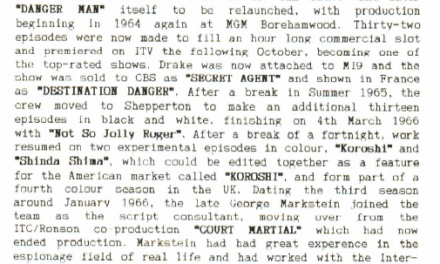While my feelings about it are somewhat mixed, Murderbot (Apple TV, 2025-), the streaming adaptation of the wonderful The Murderbot Diaries series by Martha Wells, expands upon one of the key elements of the book series: the serial-within-the-series called The Rise and Fall of Sanctuary Moon (SM). For those unfamiliar with any of these texts, I will stick with the AppleTV series (but highly recommend the novels and novellae). So, in Murderbot, the character calling itself Murderbot (Alexander Skarsgård) is a sentient, artificially created construct or a mix of organic and mechanical parts. Most SecUnits (Murderbot’s designation) are used as security personnel on remote outposts, treated as equipment and are often abused. SecUnits also have a ‘governor module’ which controls them; Murderbot, however, managed to hack its own module, rendering the module ineffective. To cope with its anxiety (from the constant stress of its job and the fact that it will be destroyed if anyone learns what it has done to its governor module) Murderbot watches a serial – in the sense of a soap opera – called The Rise and Fall of Sanctuary Moon. While the representation of Murderbot-as-fan is certainly worth examining (#stealthisidea), it is the show-within-the-show that I wish to focus upon in this blog.
Metatextuality is hardly uncommon in media. The idea of a show-within-a-show in general is often to provide additional context – one can perhaps view it as an internal paratext (intertext? intratext?) to the main diegesis (cf Gray 2010). Murderbot is no exception to this, but its SM is a series of disconnected short clips from different episodes shown with little context from its own diegesis. We cannot analyse the plot or characters or other strictly textual elements of SM on their own because there is not enough of the show-within-a-show to do so. Yet the because the SM clips seem to comment upon the main series (i.e., Murderbot and the plot points around which these SM clips are shown), it is clearly engaging in critique.

Murderbot serial-within-the-series called The Rise and Fall of Sanctuary Moon
There are a few key elements to its critique, however. Gray (2010) notes that casting is often intertextual and SM features both John Cho (Star Trek ‘Kelvinverse’ films) and Clark Gregg (MCU) who are well-known amongst fans of contemporary sf/fantasy, particularly adaptations from earlier forms. The heavy stylisation evokes ‘60s and ‘70s era science fiction (Britton and Barker 2003), particularly (though not exclusively) Classic Star Trek (CBS, 1966-1969), Classic Doctor Who (BBC, 1963-present), Blakes 7 (BBC, 1978-1981) and a handful of others.[i] While pastiche is often uncritical (Higson 2012), Murderbot very clearly uses the exaggerated unreality of SM to comment upon the complexities of the various interpersonal and life-threatening situations Murderbot finds itself in over the course of the series. Its interactions with the human characters it is assigned to protect in the series begin through direct mimicry of dialogue from SM – we are shown intercut clips of the main series and SM, particularly when Murderbot malfunctions in 1.4 as a way to reinforce this point. While subsequent SM scenes can be read as expressing Murderbot’s emotional state rather than it engaging in direct mimicry as part of its interpersonal interactions, that is not the only way SM functions within the series. The heightened melodrama also both connects and positions Murderbot within wider genre history (cf Geraghty 2009). Though not the way Murderbot relates to SM, the audience recognises the show-within-the-show as evoking that generic history through not simply showcasing a pastiche. Rather, through paralleling the main text and SM, it encourages the audience to recognise that SM is not only a construction but is incomplete. As such, the parasocial relationships and representation of (un)reality can be a starting point for Murderbot but not the end point in its development as a person.
But there is that very clear unreality, one which is immediately recognisable to those of us who have grown up watching sf/fantasy. Murderbot, though clearly telefantasy, has a relatively grounded and realist aesthetic in its mise-en-scène (colour palettes, set design, prop design, costume, et cetera) and performances. SM, as the image chosen to go along with this shows, is heavily stylised, with bright colours and some pseudo-Shakespearean costuming – this unreality is why Murderbot enjoys the serial. The acting is theatrical, evoking melodrama, soap opera and the acting styles of early telefantasy. One can certainly read this as subverting gender norms – though self-identifying as genderless, the character is played by a male actor and soap operas are more commonly associated with female audiences. I would argue, however, that the (meta)commentary done by SM also illustrates the importance of an area that is not analysed enough in television: its aesthetics (cf Walters 2024). The style and stylisation of SM, despite being a clear pastiche of multiple series across multiple countries, is so immediately recognisable that any sort of SM-diegetic coherence is unnecessary. The aesthetics alone convey the point: the production team are aware of generic history.
Thus, what SM ultimately does is to position all of those genre series which have come before as being the foundation for Murderbot. Nostalgia can certainly be used to draw or retain an audience, yet because SM proves somewhat incomplete as a basis for Murderbot’s understanding of humans and interpersonal relationships, it also functions subversively ‘…that is, as a prompt to read outside of the narrative that nostalgia itself creates’ (Vernon 2016: 120). As Murderbot grows as a character, it and those it cares for learn to question, critique and shed their naiveté about the diegetically real world they live in. Yet those early influences that shape us, incomplete though they are, still carry ‘affective charge and private significance’ and/or ‘enters a cultural repertoire which ‘holds’ the interest of the fan and constitutes the subject’s symbolic project of self’ (Hills 2002: 77). While saying that Murderbot is us and we are it would be a vast overstatement, given the expectation that most viewers of Murderbot would be fans of sf/fantasy, the aesthetics of SM can certainly speak to all of us with both its style and substance.
Dr Melissa Beattie is a recovering Classicist who was awarded a PhD in Theatre, Film and TV Studies from Aberystwyth University where she studied Torchwood and national identity through fan/audience research as well as textual analysis. She has published and presented several papers relating to transnational television, audience research and/or national identity. She is currently an independent scholar. She is under contract with Lexington/Bloomsbury for an academic book on fictitious countries and Palgrave for a book on Canadian crime dramas. She has previously worked at universities in the US, Korea, Pakistan, Armenia, Ethiopia, Cambodia and Morocco. She can be contacted at tritogeneia@aol.com.
References
Britton P and Barker (2003) Reading Between Designs: Visual Imagery and the Generation of Meaning in The Avengers, The Prisoner and Doctor Who. Austin: University of Texas.
Geraghty L (2009) Animating science fictions of the past and present in Futurama. In Geraghty, L. (ed). Channeling the Future: Essays on Science Fiction and Fantasy Television. Plymouth: Scarecrow, pp. 149-166.
Gray J (2010) Show Sold Separately: Promos, Spoilers, and Other Media Paratexts. NY: NYU Press.
Higson A (2012) Re-presenting the national past: Nostalgia and pastiche in the heritage film. In Film Genre Reader IV, edited by Barry Keith Grant. Austin: University of Texas Press, pp. 602-627.
Hills M (2002) Fan Cultures. London: Routledge.
Tinic S (2005) On Location: Canada’s Television Industry in a Global Market. Toronto: University Of Toronto Press.
Vernon M (2016) Subversive nostalgia, or Captain America at the museum. The Journal of Popular Culture 49(1): 116-135.
Walters J (2024) Finding words: Aesthetic criticism and television. Critical Studies in Television: The International Journal of Television Studies 19(1): 75–93
Footnote
[i] It is also worth noting that the series films in Ontario, Canada; sf/fantasy series often film in Canada (Tinic 2005) meaning that there is also a potentially-recognisable landscape for viewers of telefantasy.





